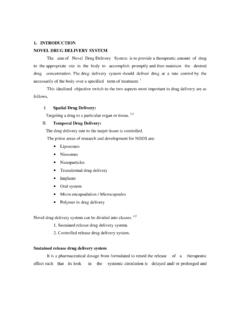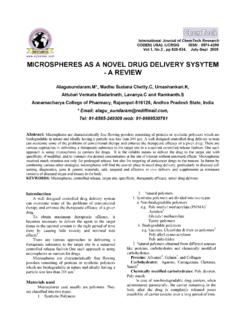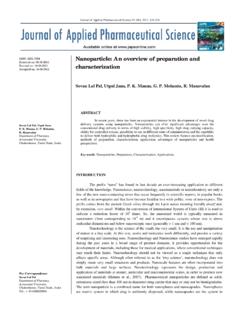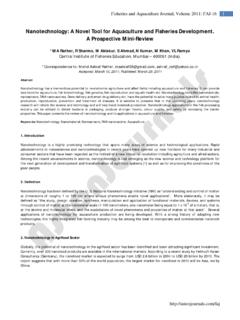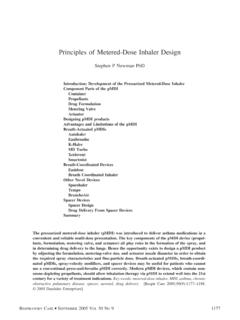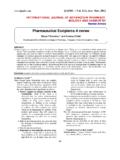Transcription of MECHANISM OF CONTROLLED RELEASE KINETICS FROM …
1 ISSN 0104-6632 Printed in Brazil Vol. 27, No. 02, pp. 211 - 225, April - June, 2010 *To whom correspondence should be addressed Brazilian Journal of Chemical Engineering MECHANISM OF CONTROLLED RELEASE KINETICS FROM MEDICAL DEVICES A. Raval1, J. Parikh1* and C. Engineer2 1 Sardar Vallabhbhai National Institute of Technology, Surat, India. E-mail: 2 Sahajanand Medical Technologies Pvt. Ltd., Surat, India. (Submitted: July 20, 2009 ; Revised: January 6, 2010 ; Accepted: January 17, 2010) Abstract - Utilization of biodegradable polymers for CONTROLLED drug delivery has gained immense attention in the pharmaceutical and medical device industry to administer various drugs, proteins and other bio-molecules both systematically and locally to cure several diseases. The efficacy and toxicity of this local therapeutics depends upon drug RELEASE KINETICS , which will further decide drug deposition, distribution, and retention at the target site.
2 Drug Eluting Stent (DES) presently possesses clinical importance as an alternative to Coronary Artery Bypass Grafting due to the ease of the procedure and comparable safety and efficacy. Many models have been developed to describe the drug delivery from polymeric carriers based on the different mechanisms which control the RELEASE phenomenon from DES. Advanced characterization techniques facilitate an understanding of the complexities behind design and related drug RELEASE behavior of drug eluting stents, which aids in the development of improved future drug eluting systems. This review discusses different drug RELEASE mechanisms , engineering principles, mathematical models and current trends that are proposed for drug-polymer coated medical devices such as cardiovascular stents and different analytical methods currently utilized to probe diverse characteristics of drug eluting devices.
3 Keywords: Drug RELEASE KINETICS ; Polymers; Stent. INTRODUCTION The development of polymeric CONTROLLED RELEASE systems introduced a new concept in drug administration to treat numerous purpose of CONTROLLED RELEASE systems is to maintain an adequate drug concentration in the blood or in target tissues at a desired value as long as possible and, for this, they are able to control drug RELEASE rate (Grassi, 1996; Langer and Wise, 1984; Pillai et al., 2001). These systems are less complicated with high stability. Biodegradable polymers have been used in CONTROLLED drug delivery for many years as a means of prolonging the action of therapeutic agents in the body, without the need to remove the device after treatment (Domb et al., 2003; Langer, 1990). The significant feature of current biodegradable devices and coatings is that they provide a continuous drug RELEASE over an extended period of time.
4 Optimized pharmacokinetic-pharmacodynamic effects of drugs is a prerequisite for a given extended drug RELEASE device to achieve favorable biological response. The drug RELEASE profile can be programmed to meet specific requirements by optimizing the composition of formulations, processing parameters such as coating level, drug-polymer ratio and type and amount of polymer-plasticizer utilized (Frohoff-H lsmann et al., 1999; Okarter and Singla 2000; Shao et al., 2002). The ideal goal for any drug eluting device is to deliver the therapeutic agent of high efficacy at the right time to the desired location with a concentration high enough over a sufficiently long period. The challenges of designing optimized drug delivery systems are similar to those of the 212 A.
5 Raval, J. Parikh and C. Engineer Brazilian Journal of Chemical Engineering work carried out routinely by chemical engineers, , device design and process design. The principles, theories and devices in chemical engineering can be modified and further developed to meet the challenges in the design of drug delivery systems. Therefore, CONTROLLED drug delivery can become a major possibility for chemical engineering to make significant contributions to human health care. The concept of combination devices, such as drug eluting components together with functional prosthetic implants, represent a multipurpose, emerging clinical technology that promises to provide functional enhancement to implant devices in various clinical applications. The latest generations of coatings have become indispensable in boosting the capabilities of medical devices and implants by improving biocompatibility, hemocompatibility and lubricity.
6 Without these coatings, many medical devices would never reach their true potential to cure the ailment for the intended application. Such coatings for medical devices are also being utilized extensively to carry out specific local drug RELEASE and make medical implants more visible to imaging systems. With targeted CONTROLLED drug delivery, combination products have already found applications in various areas of cardiovascular disease, diabetes, orthopaedics and cancer (Dubin, 2004). Using novel CONTROLLED RELEASE formulations, drug eluting stents (DES) were developed to target post angioplasty complications. They revolutionized the field of interventional cardiology by proving safety and efficacy in prevention of restenosis of coronary arteries using local drug delivery in many clinical trials (Colombo et al.)
7 , 2003; Moussa et al., 2004). FDA approval of the drug-eluting coronary stent (CypherTM from Cordis) in 2003 opened the gate for broadly adapting similar technology to combine the device and pharma worlds that have remained largely separate to date. In this article, we review drug delivery through coronary stents in different parts. The first part summarizes the importance of drug RELEASE KINETICS on the overall performance of stent s safety and efficacy. The second part discusses mechanisms of drug RELEASE for CONTROLLED drug delivery systems and coronary stents, factors affecting drug elution, significance and updates on computational modeling for understanding and prediction of RELEASE KINETICS , and the importance of advanced analytical methods for characterization-evaluation of essential attributes of DES.
8 Novel surface analysis methods such as atomic force microscopy, confocal Raman microscopy and scanning tunneling microscopy enable us to investigate surface parameters and factors like physical properties, chemical composition and spatial distribution of molecules that play the vital role in determination of overall device biocompatibility and performance. The third part covers the comparison of key performance parameters of clinically investigated major drug eluting stents and factors to consider when designing future stent base drug delivery systems. The concept of combination devices that integrate drug releasing components with various medical devices, especially cardiac stents, represents emerging technology in the treatment of coronary artery diseases. Here we have attempted to compile and discuss almost all essential design parameters that affect the drug releasing characteristics of DES, the significance of different mathematical models and sophisticated analytical techniques to investigate the underlying facts of DES.
9 Essential technical information on clinically acclaimed DES is discussed in order to utilize such information in the development of optimized drug releasing properties of DES with the use of novel biomaterials. IMPORTANCE OF CONTROLLED DRUG ELUTION FOR DES CONTROLLED RELEASE (CR) of drugs can be achieved by incorporating them either in dissolved or dispersed form in polymers (Wise, 2000). Depending on the final desired elution profile, these systems can be tailored to deliver the drug at a constant rate, in pulsatile manner, in the form of extended RELEASE and in other forms. Stent based delivery systems require a supply of anti-proliferative, anti-inflammatory, anti-thrombotic or pro-healing drugs at a programmable rate to maintain sufficient arterial drug concentrations to avoid excess cell growth with no toxic effects.
10 Therefore, out of many CONTROLLED RELEASE methods, only a few of them can practically be put into practice to accomplish the objectives set for cardiovascular applications. Designing a stent based drug delivery system demands an adequate understanding of the pathophysiology of the restenotic mechanisms that initiate after stent implantation. Targeting each of the individual MECHANISM is the rational approach to prevent adverse events. This can be done by maintaining a sufficient drug concentration, within the range of the safe and effective dosage of the drug MECHANISM of CONTROLLED RELEASE KINETICS from Medical Devices 213 Brazilian Journal of Chemical Engineering Vol. 27, No. 02, pp. 211 - 225, April - June, 2010 utilized. The rate-controlling system ensures drug retention during stent deployment and modulates drug-elution KINETICS .










